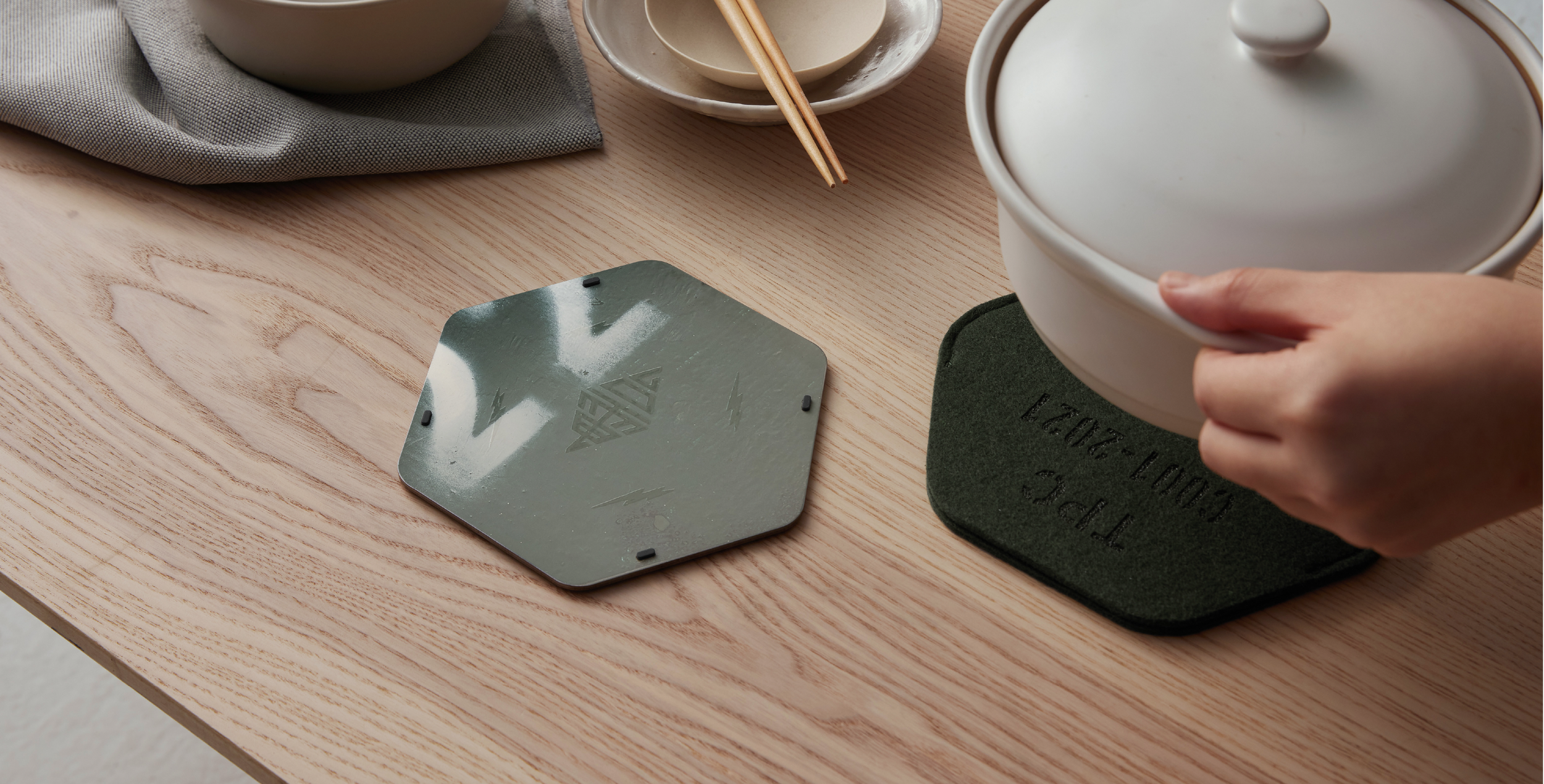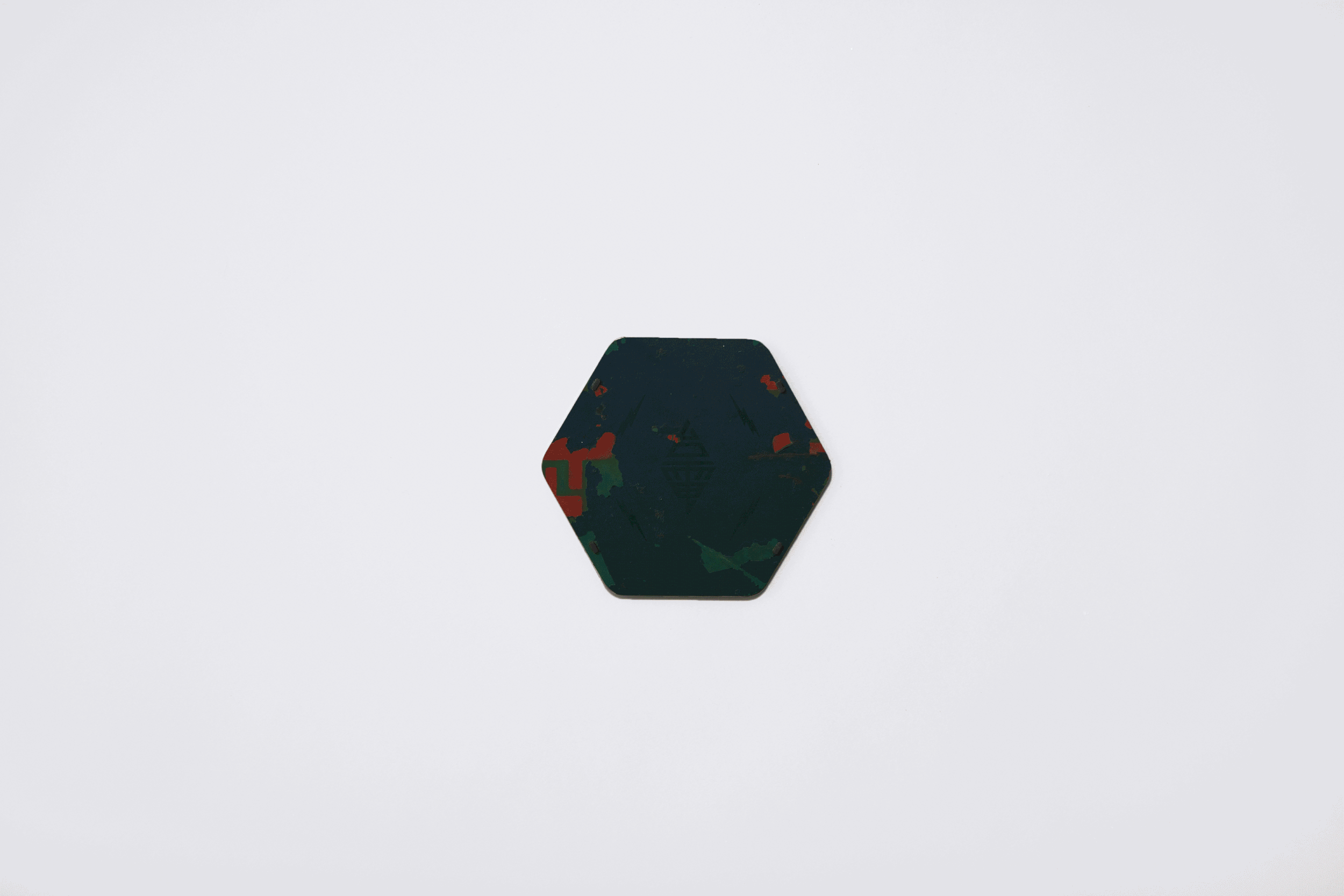TPC Trivet Set
NAKNAK internship • upcycling material • manufacturing

TPC Trivet
Launched Summer 2021
The set of 2 potholders is designed to celebrate upcycled materials from Taiwan Power Company’s retired electrical boxes. The set consists of a metal trivet and its felt sleeve that doubles as a pot-holder.

Obsolete Electrical Boxes
Our client TPC, short for Taiwan Power Company, is the national electricity supplier in Taiwan. Their electrical boxes are installed throughout the island wherever there’s coverage; but more than that, there are tons of obsolete electrical boxes in their storage warehouse accumulated over the years. Thinking that recycling the boxes as industrial scraps doesn’t do them justice, TPC initiated the electrical box project to repurpose these retired electrical boxes that served the citizens to their fullest.
Patterns Tell Stories
There are patterns and marks over the electrical boxes, be it paintings, graffiti, TPC’s own logo, stickers, markings, etc. These represent stories that each electrical box went through and carried on; each electrical box is an artifact with a history of its own. It just made so much sense that celebrating and preserving the patterns became the main goal driving many of the design decisions of the project.

65,000 pieces
Each is Unique
Bring home a piece of Taiwanese street scenery,
Let the electrical boxes continue to be part of your daily life.
Spot Gloss Patterning
Two variations of the pattern were printed in clear varnish to add subtle detail, mimicking the spot gloss technique used in book-cover printing. The screen-printed patterns are only visible from certain angles, so it doesn’t steal the spotlight from the original pattern of the electrical box.
Laser Etched
Material Origin
For this project, TPC gathered electrical boxes from all 22 regions in Taiwan, including outlying islands. The laser-etched letters stand for the province from which the electrical box is sourced.
This really complicated the manufacturing process, but we thought showing where the material came from would help put into context how the product was once (part of) an electrical box that you’d see every day right down the streets, and hopefully, this would foster a deeper connection between people and products.
Packaging as a
Second Piece
To eliminate the use of one-time plastic packaging, we designed a sleeve for the trivet, that would be its packaging, and would also serve as a second pot-holder, making the product a set of 2. The felt sleeve is made out of 90% recycled fiber, and the patterns are embossed (instead of printed) for recyclability.

Material Exploration
Machining recycled material is different from machining new material, especially in our case, we were trying to preserve the paint coating outside of metal, which in a way limits manufacturing possibilities. However, we tried different things and were trying to find the best manufacturing techniques that’d bring the best out of the material.
The heart of the project is to
honestly present the material,
celebrate both its flaws and sparkles.
Layered Print ——
Laser Engraving
Electrical box surfaces are often layered with paint. Using patterning methods such as Laser Etching or engraving reveals the color of the paint underneath the surface layer.
Draw Attention to the Material
rather than the design
Keeping a simple hexagonal shape with a whole surface area so that the material remains prominent while the design steps back as a secondary element.
Long Search for the Right Finish
Marks, scratches, chipped paint, etc. are all part of the material’s charm. However, to ensure the quality of the end product and its use, all the patterns, as well as imperfections, are enclosed/ wrapped/ sealed under a fine layer of protective coating.
With already existing paint on the surface that is heat-sensitive, the coating process became really tricky. It took months to find the right factory and to test out the right finishing and processes.
Learning from
Manufacturing Partners
Through onsite visits, prototyping, and meetings, as we learn more about manufacturing capabilities specific to each factory, we alter our designs around them, or we brainstorm with manufacturers to achieve what we hope to. A lot of the factories we approached were really down to earth and willing to share their knowledge. I really appreciate this experience.
Interact with the Manufacturing World
Being able to speak to manufacturers and to be present at production lines was extremely eye-opening for me. Throughout this project, we paid visits to metal processing factories, felt factories, soft goods assembling factories, screen-printing factories, powder coating, and liquid coating factories, an injection molding factory, and a packaging and assembly factory.
I’ve learned to understand that manufacturers and designers come from very different professional backgrounds and can have different priorities within the same project, and this makes communication super important.
The time and effort to bring a product to life is no less than, if not more, designing the product itself. The journey of figuring out the production processes for the TPC trivet set taught me to appreciate products even more.
Thank you to my coworkers and managers at NAKNAK who gave me an eye-opening introduction to the manufacturing world. You made my gap year so fun and memorable! Also shouting out to the TPC Creative team for trusting NAKNAK and being such good partners throughout the project. It was an honor to be part of such a meaningful project that represents the collective memory of the Taiwanese people.

































